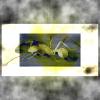So I tried looking up "murder hornet" in Japanese, and all I could find were references to killer bees (the Africanized honeybee).
After some more digging I believe the much-ballyhooed murder hornet is actually called the Giant Sparrow Hornet/Wasp in Japanese ( https://ja.wikipedia.org/wiki/オオスズメバチ for anyone interested). Normal hornets are called sparrow hornets/wasps anyway (Japanese doesn't really distinguish in the base word "hachi" among bees, wasps, and hornets). People are making jokes about the giant hornet in America now, but in Japan they are apparently the number one cause of wildlife-triggered death. It's only funny as long as your family isn't the one that draws the short straw.
But I did find this article about how Asian honeybees (Apis cerana according to the above wiki article) have developed a defense against the hornet, something the European A. mellifera cannot do: cooking the scouts. This is really, really cool. Check out the Nat Geo video embedded in this article for how they signal each other, etc.
EDIT: Speaking of which, apparently the giant hornet starts up a warning rattling sound in their nest when an intruder comes too close. If you hear what looks like a hornet nest rattling, stay far away.
https://www.foxnews....r-hornet-report
Edited by OhNoNotAgain, May 4 2020 - 4:33 PM.


















